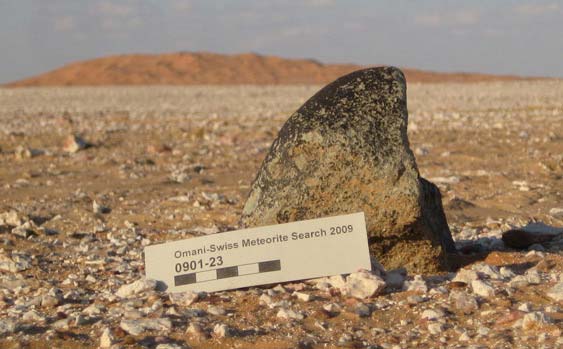Searching for Meteorites in the Deserts of Oman

Meteorites provide valuable information about the early history of the solar system. A group of Swiss geologists have conducted systematic meteorite searches in Oman since 2001, and they recently returned from their latest hunt.
Most meteorites are fragments of asteroids, some of which contain organic matter. Some meteorites preserve information on the chemical make-up of the solar system before the planets formed. Other meteorites are impact debris from the surfaces of the Moon and Mars. Martian and lunar meteorites, which are rare, are often fragments from the past, having been knocked off into space millions or even billions of years ago. .
Meteorites provide the only samples from Mars that we have in hand to analyze in a laboratory. We do have material collected by astronauts from the Moon, but lunar meteorites provide clues to early processes in the Earth-Moon system, such as the late heavy bombardment. That's the period when huge numbers of meteorites pelted the Earth and Moon 3.9 billion years ago, just when life may have started on our planet.
"Searching for meteorites is of paramount importance for astrobiology and planetary science," according to Beda Hofmann, head of Earth Science at the Natural History Museum in Bern, Switzerland. Hofmann and Edwin Gnos of the Natural History Museum in Geneva, Switzerland lead the Oman meteorite hunts.
For 30 years, the cold desert of Antarctica has been one of the richest sources of pristine meteorites. The black stones are easy to pick out from the white snow, and there are no rivers or other natural processes to carry the meteorites away. More recently, the hot deserts of Africa and Australia also have produced new meteorite discoveries. The dry conditions in deserts tend to preserve stones, and the lack of rain means they are less likely to become eroded or be covered over by sediment.
In 1999, more meteorites appeared on the market due to activity by private collectors and dealers working in Oman. Located in southwest Asia on the Arabian Peninsula, the Oman project is the only long-term search program currently being conducted in a hot desert.
Within the last ten years Oman has yielded almost one-fifth of the world's meteorites, a hoard of more than 5000 samples weighing four tons. The Oman finds include one-third of all known lunar meteorites, and a handful of specimens from Mars.
Get the world’s most fascinating discoveries delivered straight to your inbox.
Amateur collectors of meteorites have been accused of inappropriately handling them and inadequately documenting their finds, making life difficult for the scientists who want to study the rocks. Amateurs found the first Mars meteorites in Oman; in fact it was the appearance (and sale) of those rocks and lunar meteorites that alerted the Swiss researchers. They enlisted the support of the government of Oman, and on their first mission in 2001, the team recovered a Mars sample.
Hofmann is proud that the meteorite collection is conducted in collaboration with the Omani government. "So far we have obtained permission to take all samples necessary to Switzerland," he says, "but the samples remain the property of the Sultanate of Oman." Eventually representative samples will be displayed in the Natural History Museum of Muscat, the Omani capital.
This year Hofmann and his team conducted a six-week campaign in January and February. Their field parties of five people used all-terrain vehicles to search for dark meteorites on the light surface of the desert plains. The 2009 campaign reaped a great harvest of 143 meteorites (totalling 123 kg), representing 80 to 100 distinct fall events (some of the meteorites broke apart into several pieces during entry into Earth's atmosphere). Most of the meteorites they found were chondrites, stony meteorites that contain chondrules. The oldest solid material surviving from the early solar system, chondrules are even more ancient than asteroids. Perhaps they are the primitive building blocks of planets.
Meteorites are the fossils from which geologists recover the history of our solar system, but most of the meteorites found in Oman did not fall on Earth recently. They have been lying in the desert for several thousand years. A major thrust of the Swiss research is to learn how the environment contaminates meteorites, and see how a meteorite might change its appearance and composition prior to discovery and conservation.
The deserts of Oman seem to be a rich source of unique meteorites, and the precious fragments can tell planetary scientists about conditions in the early solar system when stony objects first formed. These fragments subsequently were glued together by gravitational attraction to construct planets, moons and asteroids. By helping us reconstruct the early history of our solar system and our planet, meteorites bring us a step closer to understanding what conditions were necessary for the origin of life on our world.
This article was provided to LiveScience by Astrobiology Magazine.
